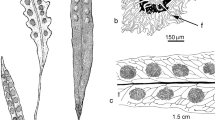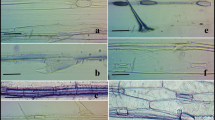Abstract
The Marantaceae family is composed of 550 species of pantropical distribution, with a strong clustering in the Neotropics. Although the family forms a monophyletic group, the circumscription of genera and consequently its phylogenetic relationships are not sufficiently understood. Its species produces silica phytoliths in varied forms, ornamentation and distribution in leaves, and these silica deposits are considered important in vegetable physiology and taxonomy. We have conducted the morphological characterisation of phytoliths and their distribution in foliar blades of Neotropical Marantaceae genera, evaluating the use of such characters to support the morphological delimitation of the genera and the physiological aspects of the family’s adaptation to rainforests. Phytoliths of 22 species of 12 genera, namely Calathea, Ctenanthe, Goeppertia, Hylaeanthe, Ischnosiphon, Koernickanthe, Maranta, Monotagma, Myrosma, Saranthe, Stromanthe and Thalia, were analysed using light and scanning electron microscopes. When comparing Neotropical species to those of the old world, one can observe the family’s homogeneity by the presence of two morphotypes in the foliar blade, the globular and the irregular, as well as stegmata associated with the fibres. However, two distinguishing features have been identified in these Neotropical species: (1) a new morphotype, the cylindroid, located in the mesophyll, (2) intra- and extracellular amorphous silica deposits associated with the stomata, which play an important role in the restriction of transpiration. In addition, the form, size and distribution of the silica deposits appear conservative in all analysed samples, which makes them useful in the morphological characterisation of the genera and species, and consequently, in the taxonomic circumscription of the Marantaceae.






Similar content being viewed by others
References
Andersson L (1981) The Neotropical genera of Marantaceae. Circumscription and relationships. Nord J Bot 1(2):218–245
Andersson L (1998) Marantaceae. In: Kubitzki K (ed) The families and genera of vascular plants IV. Flowering plants-monocotyledons: alismatanae and commelinanae (except gramineae). Springer, Berlin, pp 278–293
Andersson L, Chase MW (2001) Phylogeny and classification of Marantaceae. Bot J Linn Soc 135:275–287
Arns KNY, Mayo SJ, Alves MV (2002) Morfologia de Marantaceae ocorrente no estado de Pernambuco. Iheringia 57:3–20
Ball TB, Gardner JS, Anderson N (1999) Identifying inflorescence phytoliths from selected species of wheat (Triticum monococcum, T. dicoccon, T. dicoccoides, and T. aestivum) and barley (Hordeum vulgare and H. spontaneum) (Gramineae). Am J Bot 86(10):1615–1623
Baran EJ, González-Baró AC, Ciciarelli MM, Rolleri CH (2010) Characterization of biominerals in species of Canna (Cannaceae). Rev Biol Trop 58:1507–1515
Bartlett ME, Specht CD (2010) Evidence for the involvement of GLOBOSA-like gene duplications and expression divergence in the evolution of floral morphology in the Zingiberales. New Phytol 187:521–541
Borchsenius F, Suárez LSS, Prince LM (2012) Molecular phylogeny and redefined generic limits of Calathea (Marantaceae). Syst Bot 37:620–635
Braga JMA (2005) Marantaceae–Novidades taxonômicas e nomenclaturais III: tipificações, sinonímias e uma nova combinação em Calathea. Acta Bot Bras 19(4):763–768
Bremond L, Alexandre A, Peyron O, Guiot J (2005) Grass water stress estimated from phytoliths in West Africa. J Biogeogr 32:311–327
Buján E (2012) Elemental composition of phytoliths in modern plants (Ericaceae). Quatern Int http://dx.doi.org/10.1016/j.quaint.2012.02.046
Bukatsch F (1972) Bemerkungen zur Doppelfarbung Astrablau-Safranina. Mikrokosmos 61(8):225
Burger LM, Richter HG (1991) Anatomia da Madeira. Nobel, São Paulo
Chase MW, Fay MF, Devey D et al (2006) Multigene analyses of monocot relationships: A summary. In: Columbus JT, Friar EA, Porter JM et al (eds) Monocots: Comparative Biology and Evolution. Excluding Poales. Rancho Santa Ana Botanical Garden, Claremont, Ca. Aliso 22. pp 63–75
Cohen AE (1984) Critical point drying-principles and procedures. In: Murphy JA, Roomans GM (eds) Preparation of biological specimens for scanning electron microscopy. AMF O’Hare, Chicago, pp 95–136
Coutinho LM (1962) Contribuição ao conhecimento da ecologia da mata pluvial tropical. Bol. Fac. Filos Cienc Let Univ Sao Paulo 18:11–219
Cronquist A (1981) An integrated system of classification of flowering plants. Columbia University Press, New York
Dahlgren RMT, Clifford HT, Yeo PF (1985) The families of the monocotyledons: structure, evolution, and taxonomy. Springer, Berlin
Derry LA, Kurtz AC, Ziegler K et al (2001) Plant phytolith source of dissolved silica in Hawaiian streams from Ge/Si ratios. Proceedings of the 11th Annual V.M. Goldschmidt conference, Abstract #3805, Lunar Planetary Science Institute, Houston, http://www.lpi.usra.edu/meetings/gold2001/pdf/3805.pdf Accessed 15 April 2012
Dickison WC (2000) Integrative plant anatomy. Harcourt Academic Press, San Diego
Dorweiler JE, Doebley J (1997) Developmental analysis of teosinte glume architecture 1: a key locus in the evolution of maize (Poaceae). Am J Bot 84(10):1313–1322
Epstein E (1999) Silicon. Annu Rev Plant Phys 50:641–664
Govindarajalu E (1968) Further contribution to the anatomy of the Marantaceae: schumannianthus virgatus (Roxb.) rolfe. P Indian As-Plant Sc 68:250–260
Grubb PJ, Jackson RV, Barberis IM et al (2008) Monocot leaves are eaten less than dicot leaves in tropical lowland rain forests: correlations with toughness and leaf presentation. Ann Bot 101(9):1379–1389
Haberlandt G (1928) Physiological plant anatomy. MacMillan Company, London
Holst I, Moreno JE, Piperno DR (2007) Identification of teosinte, maize, and tripsacum in Mesoamerica by using pollen, starch grains, and phytoliths. Proc Natl Acad Sci USA 104:17608–17613
Johansen DA (1940) Plant microtechnique. McGraw-Hill, New York
Judd WS, Campbell CS, Kellog EA, Stevens PF (1999) Plant systematics—a phylogenetic approach. Sinauer Associates, Massachussets
Kress WJ (1990) The phylogeny and classification of the Zingiberales. Ann Missouri Bot Gard 77(4):698–721
Kress WJ (1995) Phylogeny of the Zingiberanae: morphology and molecules. In: Rudall PJ; Cribb PJ; Cutler DF and Humphries CJ. Monocotyledons: systematics and evolution. Royal Botanical Gardens, Kew, pp 443–460
Kress WJ, Prince LM, Hahn WJ, Zimmer EA (2001) Unraveling the evolutionary radiation of the families of the Zingiberales using morphological and molecular evidence. Syst Biol 50(6):926–944
Lee DW, Graham R (1986) Leaf optical properties of rainforest sun and extreme shade plants. Am J Bot 73(8):1100–1108
Ley AC, Claßen-Bockhoff R (2009) Pollination syndromes in African Marantaceae. Ann Bot 104:41–56
Lindorf H (1980) Estructura foliar de quince Monocotiledoneas de sombra del bosque nublado de Rancho Grande I bifaciales: araceae, Marantaceae y Musaceae. Mem Soc Cienc Nat La Salle 40(113):19–72
Lux A, Luxová M, Hattori T et al (2002) Silicification in sorghum (Sorghum bicolor) cultivars with different drought tolerance. Physiol Plant 115:87–92
Mazumdar J (2011) Phytoliths of pteridophytes. S Afr J Bot 77:10–19
McClaran MP, Coder M (2003) Phytolith shape and chemical composition in desert grassland plants. J Ariz-Nev Acad Sci 36(1):21–33
McNaughton SJ, Tarrants JL, McNaughton MM, Davis RD (1985) Silica as a defense against herbivory and a growth promotor in African grasses. Ecology 66(2):528–535
Metcalfe CR (1954) Recent work on the systematic anatomy of the monocotyledons-with special references to investigations at the Jodrell Laboratory at Kew. Kew Bull 9(4):523–532
Metcalfe CR (1963) Comparative anatomy as a modern botanical discipline-with special reference to recent advances in the systematic anatomy of monocotyledons. Adv Bot Res 1:101–147
Mulkey SS, Smith AP, Wright SJ (1991) Life history and physiology of two understory Neotropical herbs. Oecologia 88(2):263–273
Parry D, Hodson M, Sangster AG et al (1984) Some recent advances in studies of silicon in higher plants [and discussion]. Philos Trans R Soc Lond B 304:537–549
Prince LM, Kress WJ (2006a) Phylogenetic relationships and classification in Marantaceae: insights from plastid DNA sequence data. Taxon 55:281–296
Prince LM, Kress WJ (2006b) Phylogeny and biogeography of the prayer plant family: getting to the root problem in Marantaceae. Aliso 22:645–659
Prychid CJ, Furness CA, Rudall PJ (2003) Systematic significance of cell inclusions in Haemodoraceae and allied families: silica bodies and tapetal raphides. Ann Bot 92:571–580
Prychid CJ, Rudall PJ, Gregory M (2004) Systematics and biology of silica bodies in monocotyledons. Bot Rev 69(4):377–440
Renard D, Birk JJ, Glaser B et al (2012) Origin of mound-field landscapes: a multi-proxy approach combining contemporary vegetation, carbon stable isotopes and phytoliths. Plant Soil 351:337–353
Rizzini CT (1997) Tratado de Fitogeografia do Brasil. Âmbito Cultural, Rio de Janeiro
Rovner I (1971) Potential of opal phytoliths for use in paleoecological reconstruction. Quat Res 1(3):343–359
Ruzin SE (1999) Plant microtechnique. The Iowa State College Press, Iowa
Sandoval-Zapotitla E, Terrazas T, Villaseñor JL (2010) Diversidad de inclusiones minerales en la subtribu Oncidiinae (Orchidaceae). Rev Biol Trop 58:733–755
Sangster AG, Hodson MJ, Tubb HJ (2001) Silicon deposition in higher plants. In: Datnoff LE, Snyder GH, Korndorfer GH (eds) Silicon in agriculture. Elsevier, Amsterdam, pp 85–113
Schmitt U, Weiner G, Liese W (1995) The fine structure of the stegmata in Calamus axillaris during maturation. IAWA J 16:61–68
Silva RJF, Potiguara RCV (2009) Substâncias ergásticas foliares de espécies amazônicas de Oenocarpus Mart (Arecaceae): caracterização histoquímica e ultra-estrutural. Acta Amaz 39(4):793–798
Smith JF, Kress WJ, Zimmer E (1993) A Phylogenetic analysis of the Zingiberales based on rbcl sequences. Ann Missouri Bot Gard 80(3):620–630
Stanley KG, Robertson EC, d’ Entremont R et al (2011) Phytolith assaying using a micron-scale electrokinetic sorting ring. Archaeol Anthropol Sci 3:309–323
Suksathan P, Gustafsson MH, Borchsenius F (2009) Phylogeny and generic delimitation of Asian Marantaceae. Bot J Linn Soc 159:381–395
Tomlinson PB (1956) Studies in the systematic anatomy of the Zingiberaceae. Bot J Linn Soc 55:547–559
Tomlinson PB (1961) Morphological and anatomical characteristics of the Marantaceae. Bot J Linn Soc 58(370):55–78
Tomlinson PB (1962) Phylogeny of the Scitamineae-morphological and anatomical considerations. Evolution 16:192–213
Tomlinson PB (1969) Commelinales-Zingiberales. In: Metcalfe CR (ed) Anatomy of the monocotyledons, vol 3. Clarendon Press, Oxford, pp 341–359
Vogel AI (1981) Química analítica qualitativa. Ed. Mestre Jou, São Paulo
Yukawa T, Stern WL (2002) Comparative vegetative anatomy and systematics of Cymbidium (Cymbidieae: orchidaceae). Bot J Linn Soc 138:383–419
Acknowledgments
The authors thank Dr. Abdelaziz ElSaid ElBayoumi (Qatar University) and Dr. Ellen Cortezzi (Universidade Federal do Rio de Janeiro) for the helpful suggestions. Thanks are also extended to André Luis de Alcântara Guimarães, Renato Pamplona Cardozo Costa and Joyce Cabral Rodrigues of Laboratório de Farmacobotânica of Universidade Federal do Rio de Janeiro for preparing many of the slides and photos used in the paper.
Author information
Authors and Affiliations
Corresponding author
Rights and permissions
About this article
Cite this article
de Albuquerque, E.S.B., Braga, J.M.A. & Vieira, R.C. Morphological characterisation of silica phytoliths in Neotropical Marantaceae leaves. Plant Syst Evol 299, 1659–1670 (2013). https://doi.org/10.1007/s00606-013-0823-9
Received:
Accepted:
Published:
Issue Date:
DOI: https://doi.org/10.1007/s00606-013-0823-9




